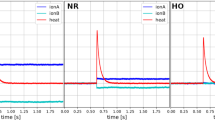Abstract
Pile-up is an unavoidable complication for cryogenic detectors with relatively large heat capacities and slow rise time, such as systems for decay energy spectroscopy employing large Au absorbers. We have simulated the spectral response of such slow cryogenic detectors using Monte-Carlo algorithms to investigate the effects of pile-up on absolute and relative activity measurements. We focus on the impact of non-distinguishable pile-up that occurs when the rising edges of two waveforms originating from different events overlap in time and are interpreted as a single event. This effect can not be readily identified and corrected in experimental data. We investigated two representative cases of absolute decay counting and plutonium isotopic analysis and find that pile-up can distort the reconstruction of both the absolute and relative activities. This Monte-Carlo methodology quantifies of pile-up effects and provides a systematic methodology for calculating corrective factors.




Similar content being viewed by others
References
K.E. Koehler, Low temperature microcalorimeters for decay energy spectroscopy. Appl. Sci. 11(9), 4044 (2021). https://doi.org/10.3390/app11094044
Y.S. Jang et al., Appl. Radiat. Isot. 70, 2255–2259 (2012)
A.S. Hoover et al., Anal. Chem. 87, 3996–4000 (2015)
M. Rodrigues et al., J. Low Temp. Phys. 193, 1263–1268 (2018)
P.C.-O. Ranitzsch et al., MetroMMC: electron-capture spectrometry with cryogenic calorimeters for science and technology. J. Low Temp. Phys. 199.1, 441–450 (2020). https://doi.org/10.15488/10169
H. Rotzinger et al., Beta spectrometry with magnetic calorimeters. J. Low Temp. Phys. 151(3), 1087–1093 (2008). https://doi.org/10.1007/s10909-008-9787-5
C. Hassel et al., Recent results for the ECHo experiment. J. Low Temp. Phys. 184(3), 910–921 (2016). https://doi.org/10.1007/s10909-016-1541-9
G.B. Kim et al., Absolute decay counting of 146Sm and 147Sm for early solar system chronology. Submitted to J. Low Temp. Phys. (2021)
G.B. Kim, A \(0\nu \beta \beta\) search using large scintillating crystal with metallic magnetic calorimeter. Dissertation, Seoul National University (2016)
S. Agostinelli et al., GEANT4—a simulation toolkit. Nucl. Instrum. Methods Phys. Res. Sect. A Accel. Spectrom. Detect. Assoc. Equip. 506(3), 250–303 (2003). https://doi.org/10.1016/S0168-9002(03)01368-8
G.F. Knoll, Radiation Detection and Measurement, 3rd edn. (Wiley, New York, 2015), pp.591–595
C.R. Bates et al., Reproducibility and calibration of MMC-based high-resolution gamma detectors. Appl. Phys. Lett. 109(2), 023513 (2016). https://doi.org/10.1063/1.4958699
M. Croce, et al., First measurements of nuclear detonation debris with decay energy spectroscopy (2021), arXiv:2103.12215v1
NNSA, NBL Program Office: Certificate of Analysis Certified Reference Material C137 (250mg) Plutonium Isotopic Standard, https://www.energy.gov/sites/default/files/2021/01/f82/C137%20%28250mg%29%20Plutonium%20Isotopic%20Standard%20Dec%202020.pdf
B. Fields, A. Melott et al., PNAS 117(35), 21008–21010 (2020). https://doi.org/10.1073/pnas.2013774117
N. Kinoshita, M. Paul et al., Science 335(6076), 1614–7 (2012). https://doi.org/10.1126/science.1215510
P. Guss et al., High-resolution photon spectroscopy with a microwave-multiplexed 4-pixel transition edge sensor array. SPIE (2017). https://doi.org/10.1117/12.2272639
Acknowledgments
This work was funded by the laboratory directed Research and development program of Lawrence Livermore National Laboratory (20-LW-024). This work was performed under the auspices of the U.S. Department of Energy by Lawrence Livermore National Laboratory under Contract DE-AC52-07NA27344. This work was supported in part by the Department of Energy National Nuclear Security Administration, Consortium for Monitoring, Verification and Technology (DE-NE000863). LLNL-JRNL-828594. This work was also supported in part by the Department of Energy National Nuclear Security Laboratory Research Graduate Fellowship. Data used in this work will be made available upon reasonable request.
Author information
Authors and Affiliations
Corresponding author
Additional information
Publisher's Note
Springer Nature remains neutral with regard to jurisdictional claims in published maps and institutional affiliations.
Rights and permissions
Springer Nature or its licensor holds exclusive rights to this article under a publishing agreement with the author(s) or other rightsholder(s); author self-archiving of the accepted manuscript version of this article is solely governed by the terms of such publishing agreement and applicable law.
About this article
Cite this article
Kavner, A.R.L., Lee, D., Boyd, S.T.P. et al. Study of Pile-Up Effects in Decay Energy Spectroscopy. J Low Temp Phys 209, 1070–1078 (2022). https://doi.org/10.1007/s10909-022-02829-2
Received:
Accepted:
Published:
Issue Date:
DOI: https://doi.org/10.1007/s10909-022-02829-2




